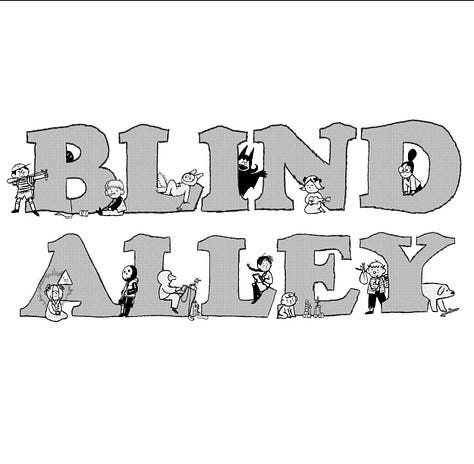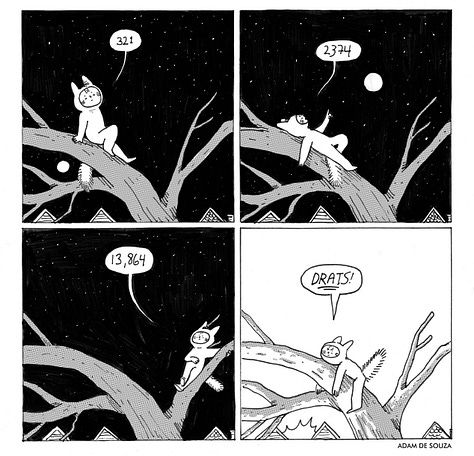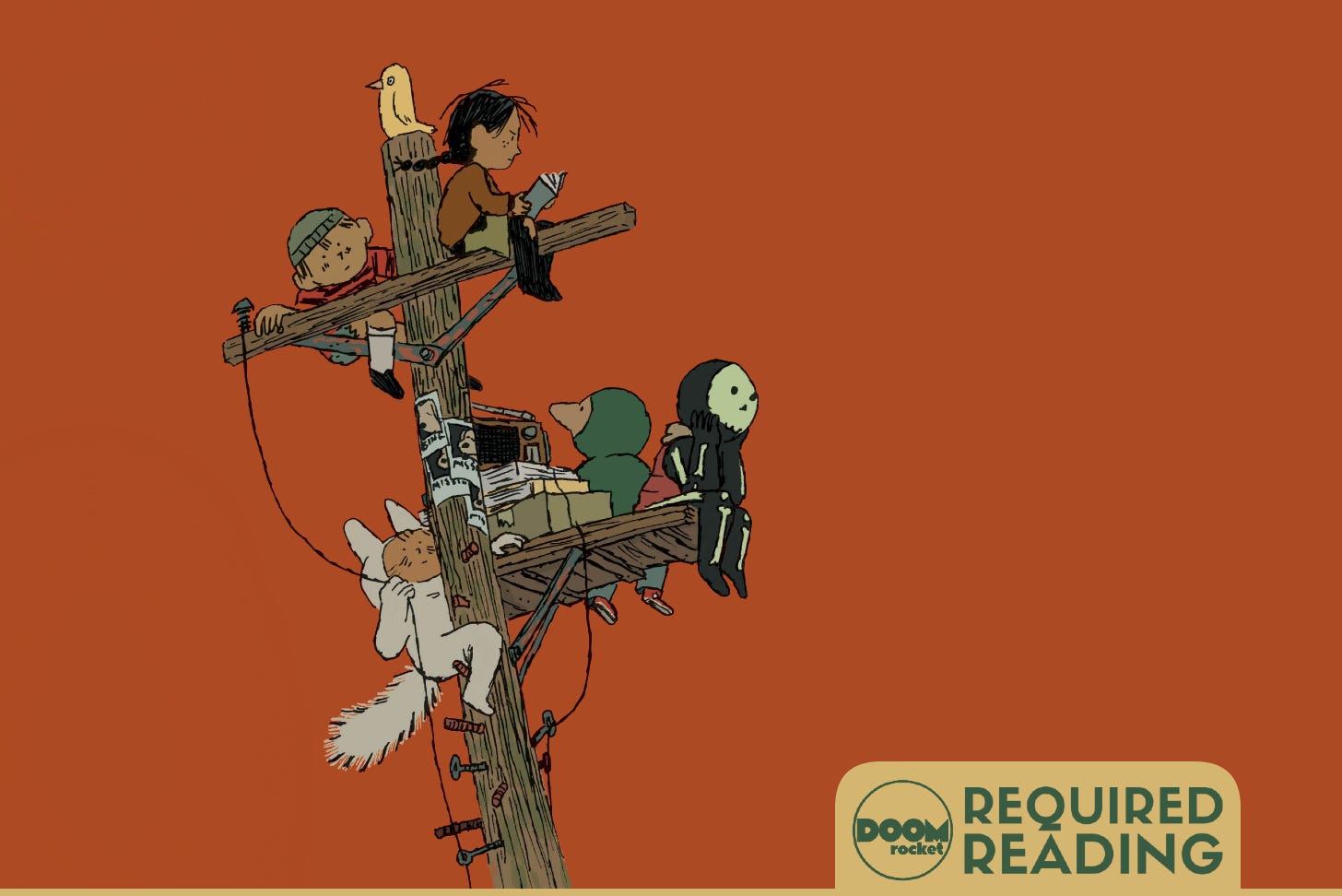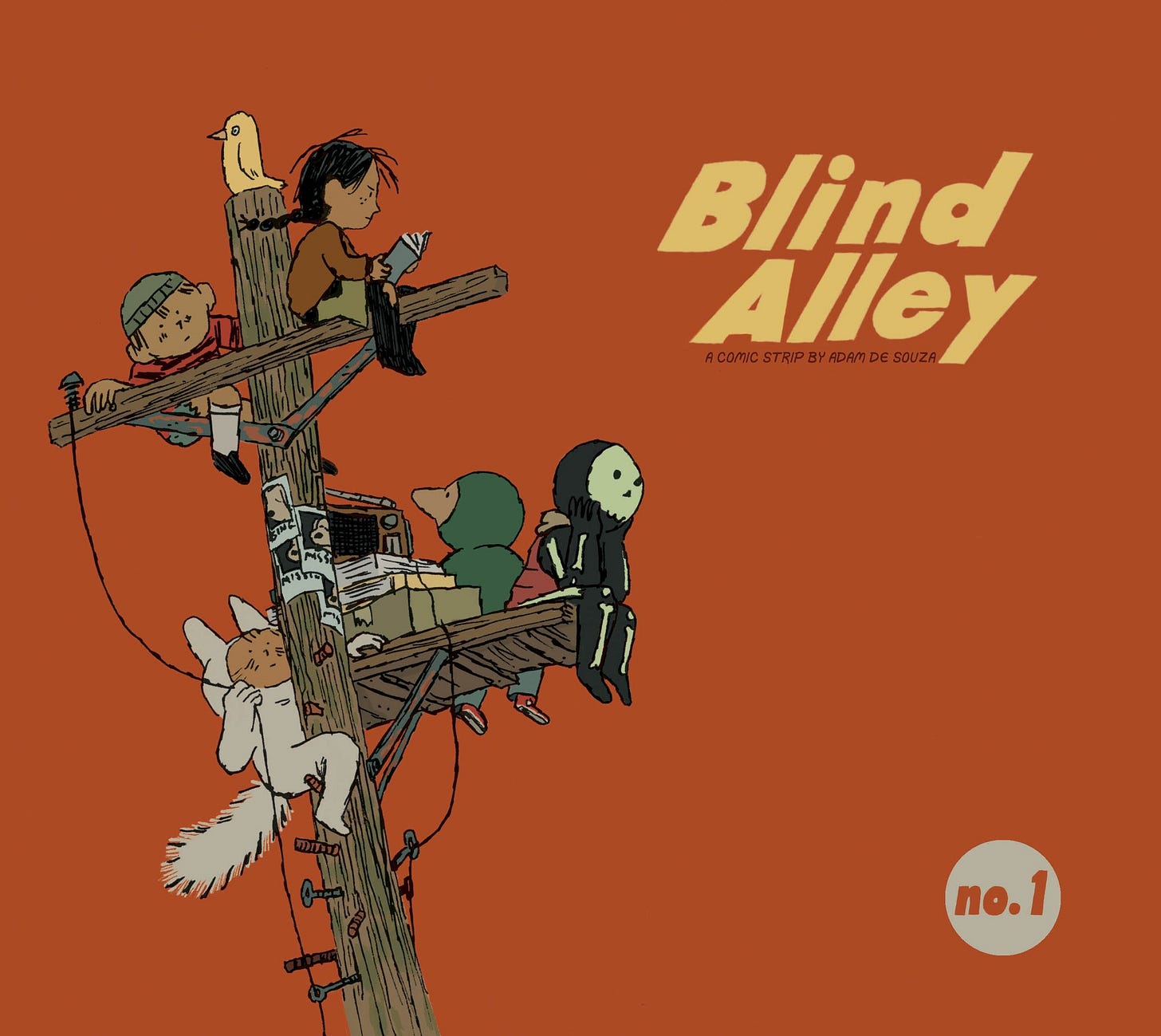Blind Alley is a singular strip of wandering, pondering philosophy
In the footsteps of Gasoline Alley and Peanuts, Adam de Souza's comic is populated with the flawed and fragile.
Required Reading is DoomRocket's love chest, opened once a month to champion a book that we adore and you should read. The latest: the first collected volume of Adam de Souza's online strip, Blind Alley, available now.
Collected like this, putting a year's worth of strips in one place instead of them showing up like Cloudbreak in the digital tumult, the story of Blind Alley comes together. Slowly, droplets gather until the leaf spills over. How the dots all came to be connected is clear to see in hindsight. But Adam de Souza's comic is a strip, not a book; so mostly, from moment to moment, it reads different. Unconcerned with story, mystery and shadowy monsters tread at the edges, making room. For hushed insight. For lying in a field. And reading manga. Hugging a tree and listening to it, wondering if there will be another hill once we reach the crest of this one, what can you knock off a fence with a good slingshot, whose cat this is. What is Blind Alley? I don't think reading it will clear a question like that up.
It's a place, home to a bunch of kids who range from fairly normal (if not vaguely retro, saddle shoes and whoopee caps) to an operatic vampire child and the loner who always wears a skull face helmet. The juvenile delinquents collect Pokémon cards, make their own comics and try to sell them, hang out in empty lots and makeshift tree forts. They talk and play, stress, yearn, break down, bliss out. Four panels about feeling bad. Four panels feeling lucky. Four panels of magical nothing. It's not a serialized storyline, nor is it episodic. Blind Alley is finding a Polaroid and reliving the moment from flash to exposure.
I guess that's not entirely true. Blind Alley starts opaque but, over time, gradually becomes clearer. There are several stories that advance throughout the book, some intersecting, visited in random rotation. Who will be in today's comic? There's room for messing around. De Souza feeling things out and putting pieces in place, following the same vibe over a bunch of unrelated strips in sequence that builds into the comic's overall tone. Suddenly, these silly, throwaway stories evoke a robust emotional depth. The choice a kid is faced with feels like the end of the world: to them, to us.
De Souza achieves this Kiarostami state of childish seriousness in two ways. Blind Alley recognizes that the moment doesn't have to move the narrative forward to matter. The fleeting joy of the sun on your face or the smell of a freshly opened pack (of cards) or when the haircut is good; just because something isn't a pivotal part of your life's story doesn't mean the kick you get out of it has no value. Following in the solemn strip-format footsteps of Gasoline Alley and Peanuts. And Blind Alley is populated with the flawed and fragile. The kids are old souls, open to empathy on a deeper level than their years would suggest. But they are kids, not yet equipped to handle all that feeling, bearing it nonetheless. They are human, not reduced, but realized.
De Souza's short-term wander and ponder, long-term storyweaving can make each Blind Alley entry read like a newspaper strip, but the look is not that at all. The balance between detail and doodle falls just far enough on the scribble side to feel unlike a strip. It looks like comics, like modern alternative comics specifically, in the neighborhood of Glenn Ganges (staring at the moon, no doubt). Sweet but somber. Detailed enough to feel real, loose enough the dog can talk and the sewer-dwelling phantom blot doesn't look out of place.
The slightly unfinished quality of the drawing is strongest in tall grass and mushrooms and bark. Unpredictable textures. De Souza has a strong sense of balance between black and white in Blind Alley, so despite the addition of grey making it technically monochrome, it serves up the page like a good B&W comic should. And yet, none of the blacks are completely filled in. The spot color locks the page down, making it feel worked and complete, while the raucous quality of the line allows the page to be free and alive.






Don't think about it. Who built her booth; in a world without adults present, where did she go to make copies of her zine? De Souza has created a space where explanation doesn't need to happen. The blot character doesn't need lore, just chocolate. And just as soon as the half-wall to lean against and opine appears, it is gone again once the four panels run out. It's not a comic book; it's a comic strip, and the life of a strip is a single day.
Might as well start asking, why are there monsters on the outskirts of town? "Why do anything at all?" What is the point of a comic? Blind Alley is a work where you can let go of anticipated structure, one where the reader waits for the story to reveal itself. I hardly knew I cared until I was shown what could be lost. Rising from my reverie and rushing into the next volume…
Blind Alley No. 1 is available now. For ordering info, click this. To dive into the Blind Alley archives, click this.
Self-published / $26
Written and illustrated by Adam de Souza.





What a lovely post! I’ve been a fan of Blind Alley since the early days and truly hope it can reach more readers.